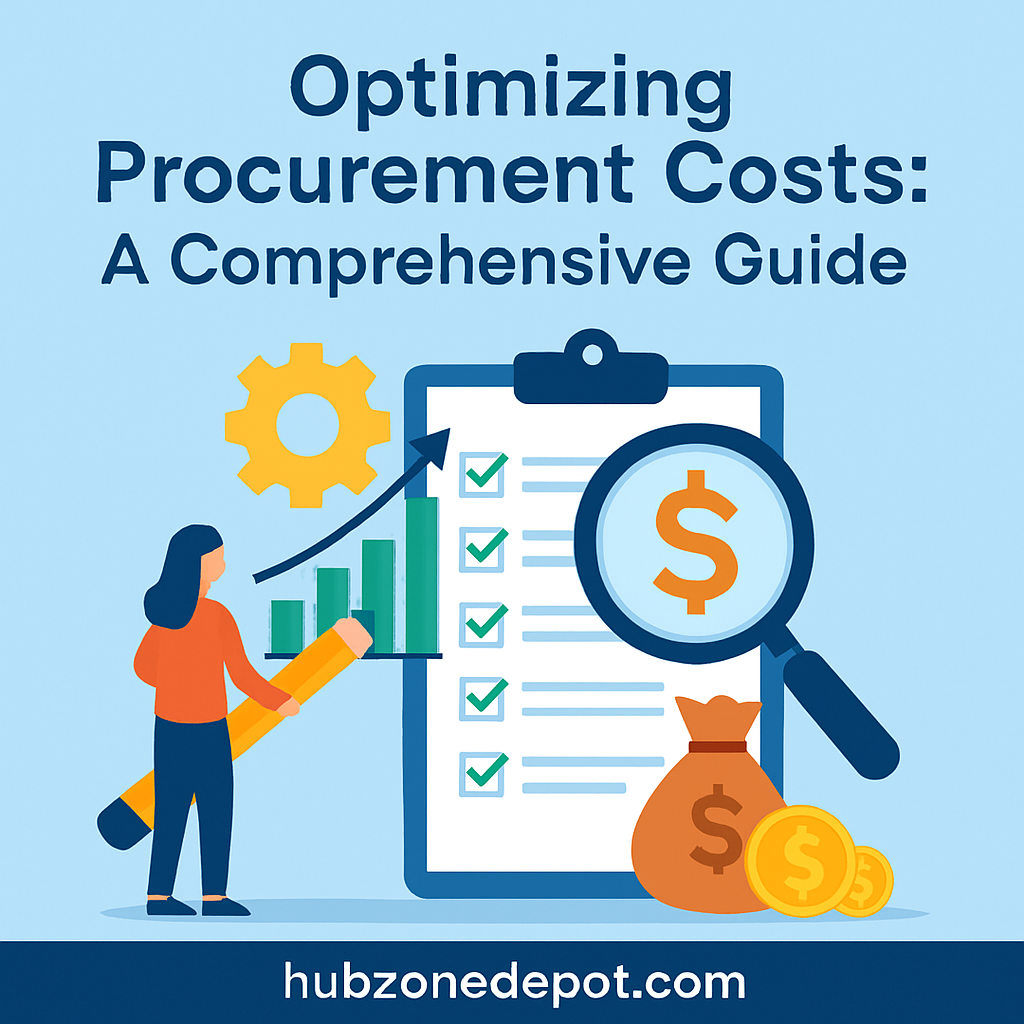Optimizing Procurement Costs: A Comprehensive Guide
Introduction
Welcome to the world of cost procurement, where every dollar counts and strategic decisions can make or break your bottom line. In today’s competitive landscape, understanding how to effectively manage procurement costs is not just a nice-to-have it’s a necessity. Think of it as the secret sauce in your business recipe that can transform a mediocre dish into a Michelin-star meal.
As purchasing directors and CFOs, you’re tasked with not only keeping the lights on but also ensuring that every penny spent translates into value. This guide is designed to help you navigate the murky waters of procurement cost management, offering insights into how you can achieve significant procurement cost savings while enhancing efficiency.
From understanding the components that contribute to your procurement costs to implementing cutting-edge strategies for reducing procurement costs, we’ll cover it all. We’ll explore how leveraging data through spend analysis in procurement and embracing technology like e-procurement solutions can lead to smarter purchasing decisions.
But wait, there’s more! We’ll also dive into the often-overlooked aspects of supplier relationship management and contract optimization for maximum savings. After all, managing your suppliers effectively can be the difference between a good deal and a great one.
Buckle up as we embark on this journey toward mastering procurement cost analysis and discovering innovative ways to enhance your organization’s financial performance!

Understanding Procurement Costs
When it comes to cost procurement, understanding what you’re dealing with is half the battle. Think of procurement costs as the price tag on everything you need to keep your business running smoothly. But wait, it’s not just about the cash you fork over; it’s about a whole ecosystem of expenses that can either make or break your bottom line.
So, what exactly are procurement costs? In simple terms, they encompass all expenses related to acquiring goods and services. This includes everything from the purchase price to shipping fees, taxes, and even the costs associated with managing supplier relationships.
The Importance of Cost Procurement in B2B Sales
In the world of B2B sales, procurement costs can feel like a sneaky ninja lurking in the shadows and ready to pounce on your profit margins. A solid grasp of these costs allows purchasing directors and CFOs to make informed decisions that not only enhance profitability but also improve operational efficiency.
Components of Procurement Costs
To tackle these costs effectively, let’s break them down into bite-sized pieces:
- Purchase Price: The obvious one! This is how much you pay for goods or services.
- Shipping and Handling: Those delivery charges can add up faster than a cat video binge-watch session!
- Supplier Management Costs: Think relationship maintenance communication, negotiations, and performance monitoring.
- Inventory Carrying Costs: Storing products isn’t free! Warehousing fees, insurance, and depreciation come into play here.
- Sourcing Costs: These include expenses related to finding the right suppliers who can deliver quality at competitive prices.
- Total Cost of Ownership (TCO): A holistic view that considers all costs over a product’s lifecycle from acquisition to disposal.
A well-rounded approach to understanding these components not only aids in reducing procurement costs but also contributes significantly to overall profitability through strategic procurement decisions.
Procurement Cost Management Strategies
When it comes to cost procurement, having a solid strategy is like having a GPS for your budget guiding you through the twists and turns of expenses while keeping you on the right track. Let’s dive into some effective procurement cost management strategies that can help you optimize your spending.
Overview of Procurement Cost Management
At its core, procurement cost management is about understanding, controlling, and reducing expenses associated with acquiring goods and services. Think of it as being the captain of your financial ship navigating through waters filled with potential savings and hidden costs. The goal? To ensure that every dollar spent contributes to your organization’s bottom line.
Key Metrics in Procurement Cost Analysis
To effectively manage costs, you need to measure them. Here are some key metrics to keep an eye on:
- Total Cost of Ownership (TCO): This includes all costs associated with a product over its lifecycle not just the purchase price. It’s like buying a car; the sticker price is just the tip of the iceberg.
- Cost per Purchase Order: Tracking this can help identify inefficiencies in your procurement process.
- Savings Realization Rate: Measure how much of your projected savings actually materialize.
Benchmarking in Procurement Costs
Benchmarking involves comparing your procurement costs against industry standards or competitors. It’s like checking your score on a test if everyone else is acing it while you’re scraping by, it might be time for a study session! Use benchmarking to identify areas where you can improve efficiency and cut unnecessary expenses.
Tip: Regularly review and adjust benchmarks based on market trends and organizational changes to ensure they remain relevant!
Implementing Strategic Procurement Costs Analysis
A comprehensive approach to analyzing procurement costs involves looking at both direct and indirect expenses. This means not only assessing what you’re spending but also understanding why you’re spending it. Are there opportunities for negotiating better terms? Could consolidating orders lead to volume discounts? These questions are crucial for effective cost reduction in procurement.

Utilizing Technology for Enhanced Procurement Efficiency
The digital age has ushered in e-procurement solutions that can streamline processes and enhance visibility into spending patterns. Think of these tools as your procurement sidekicks ready to help you track expenses, analyze data, and even automate repetitive tasks. By leveraging technology, organizations can achieve significant reductions in both time and costs.
According to recent studies, companies that adopt e-procurement solutions report up to 30% savings on their overall purchasing costs.
The key takeaway here is simple: effective procurement cost management isn’t just about cutting corners; it’s about smart spending that aligns with your organization’s goals. By implementing these strategies, you’ll be well on your way to optimizing procurement expenses while enhancing overall efficiency!
Cost Reduction Techniques in Procurement
When it comes to cost procurement, finding ways to trim the fat is essential. Think of procurement as a budget-conscious chef: they need to whip up a gourmet meal without breaking the bank. Here are some deliciously effective techniques for reducing procurement costs:
- Identifying Areas for Cost Savings: Start by conducting a thorough spend analysis in procurement. This will help you pinpoint where your money is going and identify potential areas for savings. Look at historical data and categorize spending to find trends.
- Procurement Expense Reduction Strategies: Implement strategies like strategic sourcing and cost management. By evaluating suppliers and considering alternative options, you can negotiate better deals or switch to more cost-effective vendors. Remember, it’s not just about price; it’s about value!
- Sustainable Sourcing and Cost Implications: Embrace sustainable sourcing practices. Not only can this enhance your brand image, but it can also lead to long-term cost savings through more efficient resource use and waste reduction. Plus, consumers love a good eco-friendly story!
Key Takeaway: Regularly review your procurement practices! The landscape is ever-changing, and what worked last year might not be the best solution today.
Let’s dive deeper into these techniques:
Identifying Areas for Cost Savings
The first step in reducing procurement costs is understanding where your expenses are coming from. Utilize tools like spend analysis software to track every penny spent across categories. This data will reveal patterns that may surprise you like how much you’re spending on office supplies versus technology upgrades!
Procurement Expense Reduction Strategies
This is where the magic happens! By implementing strategic sourcing practices, you can leverage relationships with suppliers to negotiate better terms or explore alternative suppliers altogether. Consider using competitive bidding processes or reverse auctions to foster competition among suppliers.
Sustainable Sourcing and Cost Implications
Sustainability isn’t just a buzzword; it’s a savvy business strategy! By opting for sustainable sourcing methods, you not only help the planet but also potentially lower costs through reduced waste and improved efficiency in operations. Plus, consumers are increasingly drawn to brands that prioritize sustainability talk about a win-win!
In conclusion, effective cost reduction in procurement isn’t about making drastic cuts; it’s about smart management and strategic decision-making. By identifying savings opportunities, employing expense reduction strategies, and embracing sustainability, you’ll be well on your way to optimizing your procurement expenses while still getting the quality you need.
Strategic Procurement Costs Optimization
When it comes to cost procurement, think of it as a game of chess. Every move counts, and strategic thinking can lead to significant cost savings. Here are some key strategies that can help you optimize procurement costs and enhance your bottom line.
Value-Based Procurement Strategies
Value-based procurement isn’t just about finding the lowest price; it’s about maximizing value for every dollar spent. This means evaluating suppliers not only on cost but also on quality, service, and reliability. By focusing on the total value rather than just the upfront cost, businesses can achieve better long-term outcomes.
Leveraging Economies of Scale in Purchasing
Imagine buying in bulk like stocking up on toilet paper during a pandemic suddenly, you’re the king (or queen) of bathroom supplies! In procurement terms, leveraging economies of scale means negotiating larger orders with suppliers to secure lower prices per unit. This strategy not only reduces costs but also strengthens supplier relationships.
Dynamic Discounting in Supply Chain Finance
Dynamic discounting is like having a secret weapon in your procurement arsenal. By offering early payment to suppliers in exchange for discounts, businesses can significantly reduce their procurement expenses. This strategy not only helps with cash flow management but also fosters stronger partnerships with vendors who appreciate timely payments.

In conclusion, optimizing procurement costs is not just about slashing prices; it’s about adopting a holistic approach that considers value, relationships, and innovative financial strategies. By applying these techniques, you can not only minimize procurement costs but also position your organization for sustainable growth.
Efficient Procurement Processes and Tools
In the world of procurement, efficiency isn’t just a buzzword it’s the secret sauce to achieving cost procurement success. With the right processes and tools, you can transform your procurement operations from a chaotic scramble into a well-oiled machine, all while keeping an eye on those all-important bottom-line figures.
E-Procurement Solutions for Cost Efficiency
Gone are the days of paper trails and manual order forms. Enter e-procurement solutions: your digital allies in the quest for cost-effective procurement strategies. These platforms streamline purchasing processes, reduce errors, and enhance visibility across your supply chain.
- Automated Workflows: Say goodbye to tedious approvals! Automation speeds up processes and cuts down on human error.
- Centralized Data: Access real-time information about spending patterns, which is crucial for effective procurement cost management.
- Supplier Integration: Seamlessly connect with suppliers to ensure competitive pricing in procurement.
Inventory Management and Purchasing Costs Control
A well-managed inventory is like a well-tuned engine; it keeps everything running smoothly. Implementing robust inventory management practices helps in minimizing procurement costs by ensuring you only purchase what you need when you need it.
- Just-in-Time (JIT) Inventory: This strategy reduces holding costs by ordering stock as it’s needed think of it as a ninja approach to inventory!
- ABC Analysis: Classify inventory based on importance to prioritize purchasing decisions efficiently.
- Safety Stock Management: Maintain just enough buffer stock to avoid stockouts without over-purchasing.
Spend Analysis in Procurement for Better Decision Making
If knowledge is power, then spend analysis is your superhero cape. By analyzing spending data, you can uncover trends that lead to significant savings opportunities.
- Categorization of Spend: Break down expenses into categories to identify areas where cost reduction in procurement can be achieved.
- User Behavior Insights: Understand who is buying what and why this knowledge can help tailor procurement strategies effectively.
- Savings Tracking: Measure the impact of implemented changes on overall procurement costs to keep everyone accountable.
Key Takeaway: Leveraging e-procurement solutions, efficient inventory management, and thorough spend analysis are essential steps toward optimizing procurement expenses and achieving long-term cost savings!
The Role of Supplier Relationship Management in Cost Savings
When it comes to cost procurement, the relationship you have with your suppliers can be the secret sauce to achieving significant procurement cost savings. Think of your suppliers as partners in crime, helping you navigate the complex world of purchasing while keeping your budget intact.
Many organizations overlook the power of effective supplier relationship management (SRM) in their quest for reducing procurement costs. But let’s be clear: a well-managed supplier relationship can transform your procurement strategy from a necessary evil into a finely-tuned machine that drives down expenses.
Supplier Negotiation for Cost Savings Techniques
Negotiating with suppliers is not just about haggling over prices like you’re at a flea market. It involves strategic discussions that can lead to lower prices and better terms. Here are some techniques:
- Be Transparent: Share your budget constraints and long-term goals. Suppliers appreciate honesty and may offer discounts or favorable terms if they see a potential for future business.
- Bundle Purchases: If you’re buying multiple products or services, consider bundling them together. This can lead to bulk discounts, which is like getting a two-for-one deal at your favorite store!
- Leverage Competition: Don’t be afraid to let suppliers know they’re not the only game in town. A little competition can go a long way in securing better pricing.
Optimizing Vendor Contracts for Savings Opportunities
Your contracts are more than just legal documents; they’re tools for cost reduction in procurement. Here’s how to optimize them:
- Review Regularly: Schedule periodic reviews of contracts to ensure they still meet your needs and reflect current market conditions.
- Add Performance Metrics: Include key performance indicators (KPIs) that tie supplier performance to pricing adjustments. If they don’t deliver, they don’t get paid as much simple as that!
- Simplify Terms: Complicated contracts can lead to misunderstandings and increased costs. Aim for clarity and simplicity to avoid costly mistakes.
Cost-Efficient Supplier Selection Criteria
Selecting the right supplier is crucial for minimizing procurement costs. Here are some criteria to consider:
- Total Cost of Ownership (TCO): Look beyond just the purchase price. Consider shipping, handling, and potential maintenance costs when evaluating suppliers.
- Sustainability Practices: Suppliers who implement sustainable practices may offer long-term savings through efficiency gains plus, it’s good for your brand image!
- Financial Stability: A financially stable supplier is less likely to hike prices unexpectedly or go out of business mid-contract both scenarios that can wreak havoc on your procurement budget optimization efforts.

Takeaway: Strong supplier relationships coupled with strategic negotiation techniques not only enhance procurement efficiency but also significantly contribute to reducing overall procurement expenses.
The Total Cost of Ownership in Procurement Decisions
When it comes to cost procurement, understanding the Total Cost of Ownership (TCO) is like having a crystal ball that reveals the true financial picture of your procurement decisions. TCO goes beyond the initial purchase price and dives deep into the ongoing costs associated with a product or service throughout its lifecycle. Think of it as the difference between buying a fancy coffee machine for your office and realizing you need to buy expensive coffee pods every week!
In today’s fast-paced business world, procurement cost management requires savvy decision-making that considers all factors contributing to total expenses. TCO includes:
- Acquisition Costs: The upfront costs, including purchase price and shipping.
- Operational Costs: Expenses related to using and maintaining the product.
- End-of-Life Costs: Disposal or recycling fees when the product is no longer useful.
This holistic view allows companies to make more informed choices. For example, while a cheaper supplier might seem appealing at first glance, a deeper dive into their pricing strategies could reveal hidden fees or subpar quality that leads to higher operational costs over time.
Key Takeaway: Always conduct a thorough TCO analysis before making procurement decisions. This can lead to significant procurement cost savings.
The Importance of Lifecycle Costing
A key component of TCO is lifecycle costing, which evaluates all costs from acquisition through disposal. This approach can help businesses identify potential savings opportunities by considering factors such as:
- Maintenance Requirements: How much will it cost to keep equipment running?
- Energy Efficiency: Will this choice lead to lower utility bills?
- Sustainability Practices: Is there an eco-friendly disposal option that could save money?
A Practical Example: The Office Printer Dilemma
Imagine you’re choosing between two office printers: one is cheaper upfront but has high ink costs and frequent maintenance needs; the other is pricier but offers lower ink usage and reliable performance. A quick TCO calculation might reveal that over five years, the more expensive printer actually saves you money!
Strategic Procurement Decisions
The concept of TCO also plays a vital role in strategic sourcing and cost management. By analyzing TCO, organizations can enhance procurement efficiency and make better supplier selections based on long-term value rather than just short-term gains.
The right approach can not only minimize procurement costs but also improve supplier relationships by focusing on value rather than price alone.
Navigating these waters requires diligence and foresight, especially when negotiating contracts. Remember, optimizing vendor contracts for savings opportunities could mean negotiating for better terms based on your total ownership costs instead of just initial pricing.
A Final Thought on Procurement Efficiency
The journey towards effective procurement cost reduction starts with understanding TCO. By incorporating this into your financial analysis, you’ll not only enhance your procurement strategy but also align it with broader business objectives leading to sustainable growth and profitability.
The Importance of Risk Management and Procurement Costs
In the world of cost procurement, risk management isn’t just a buzzword; it’s a critical component that can make or break your procurement strategy. Imagine sailing a ship without checking the weather forecast sure, you might get lucky, but more often than not, you’ll find yourself in stormy seas. Similarly, neglecting risk management in procurement can lead to unexpected expenses and inefficiencies.
When we talk about procurement cost management, we can’t ignore the potential pitfalls that come with it. Risks in procurement can arise from various sources:
- Supplier Reliability: What happens if your go-to supplier suddenly goes out of business? Your procurement costs could skyrocket as you scramble to find alternatives.
- Market Fluctuations: Prices for raw materials can change overnight due to geopolitical tensions or natural disasters. A solid risk management plan helps mitigate these unpredictable shifts.
- Compliance Issues: Failing to adhere to regulatory requirements can lead to hefty fines, further inflating your procurement costs.
To effectively manage these risks, organizations should integrate comprehensive risk assessments into their procurement cost analysis. Here are some strategies that can help:
1. Conduct Thorough Risk Assessments
This involves analyzing potential risks associated with suppliers and market conditions. Use tools like SWOT analysis to identify strengths, weaknesses, opportunities, and threats related to your suppliers.
2. Develop Contingency Plans
No one likes surprises especially when they come with a price tag! Having contingency plans ensures you’re prepared for unexpected events. For instance, maintaining relationships with multiple suppliers can provide backup options when needed.
3. Leverage Technology for Risk Monitoring
E-procurement solutions offer real-time data analytics that help monitor supplier performance and market trends. This tech-savvy approach allows you to proactively address risks before they escalate into costly issues.
Key Takeaway: Integrating risk management into your procurement processes not only protects against unforeseen costs but also enhances overall efficiency and effectiveness in managing your procurement budget.
The relationship between risk management and procurement costs is akin to a dance; both partners must move in harmony for the best results. By adopting strategic sourcing and cost management practices while keeping an eye on potential risks, organizations can achieve significant procurement cost savings.
Conclusion
As we wrap up our deep dive into the world of cost procurement, it’s clear that optimizing procurement costs is not just a nice-to-have it’s a must-have for any savvy business looking to thrive in today’s competitive landscape. By implementing strategic procurement cost management practices, companies can unlock significant procurement cost savings that directly boost their bottom line.
Remember, effective procurement cost analysis and understanding the total cost of ownership in procurement decisions are essential. It’s not just about the sticker price; consider factors like supplier reliability and lifecycle costs. This holistic approach to cost reduction in procurement will ensure you’re not only saving money but also investing wisely.
Moreover, don’t underestimate the power of strong supplier relationships. Effective supplier negotiation for cost savings can lead to mutually beneficial arrangements that enhance both parties’ efficiency and profitability. And let’s not forget about leveraging e-procurement solutions these tools are game-changers, offering streamlined processes that lead to substantial savings.
In conclusion, optimizing procurement expenses is an ongoing journey. It requires a commitment to continuous improvement, smart decision-making, and a willingness to adapt as market conditions change. So gear up, embrace these strategies, and watch your procurement operations transform into a powerhouse of efficiency and cost-effectiveness!



